Слайд 2

Слайд 3

One of the first philosophers to really engage with cognitive science
Слайд 4

One of the first philosophers to really engage with cognitive science
Wrote
an important book on cognitive architecture; argued that the mind is “modular” (this will re-emerge in the week where we discuss evolutionary psychology)
Слайд 5

Слайд 6

Fodor, J. (1974) “Special Sciences (Or: The Disunity of Science as
a Working Hypothesis)”
Слайд 7

a bit of background on the issues...
Слайд 8

One of the early criticisms of cognitive science was that some
models seemed very unconcerned about how the brain actually worked
Consider Chomsky’s work in linguistics, which we talked about on Day 1
There, one is concerned with uncovering the rules that generate all and only the grammatical sentences of some natural language
There isn’t (or, in the early days, wasn’t) much interest in how the brain actually encodes those rules
Слайд 9

There has also been a long-standing issue in philosophy of science
about how some sciences relate to others
For instance, if everything is just physical stuff, then why do we have other sciences at all?
How do these “special sciences” (anything other than physics) relate to the physical sciences?
Слайд 10

Logical positivists were very interested in reduction
The account of reduction that
Fodor provides comes to a large extent from Ernet Nagel (1901-1985)
Слайд 11

Fodor distinguishes two claims
whether physics is universal, that is, whether everything
is ultimately physical
whether reducibility to physics should be a guide to how to construct theories and laws in the special sciences
Слайд 12

...and three theses
token physicalism: “all the events that the sciences talk
about are physical events” (p. 100)
Слайд 13

...and three theses
token physicalism: “all the events that the sciences talk
about are physical events” (p. 100)
materialism: all events can be described by some science and that token physicalism is true
Слайд 14

...and three theses
token physicalism: “all the events that the sciences talk
about are physical events” (p. 100)
materialism: all events can be described by some science and that token physicalism is true
Can someone explain what the difference is between token physical and materialism?
Слайд 15

...and three theses
token physicalism: “all the events that the sciences talk
about are physical events” (p. 100)
materialism: all events can be described by some science and that token physicalism is true
reductivism: “the conjunction of token physicalism with the assumption that there are natural kind predicates in an ideally completed physics which correspond to each natural kind predicate in an ideally completed social science” (p. 100)
Слайд 16

Fodor endorses token physicalism (and probably materialism)
But he rejects reductivism.
Moreover, Fodor
claims that, if reductivism is false, then a reduction (in the standard sense) cannot occur between a higher-level science and physics.
Слайд 17

First, let’s be more clear about what a “reduction” is, at
least for Fodor
Слайд 18

conditionals
“P ? Q” is read “If P, then Q”
(The term to
the left of the arrow is called the “antecedent” and the term to the right is called the “consequent”)
Слайд 19
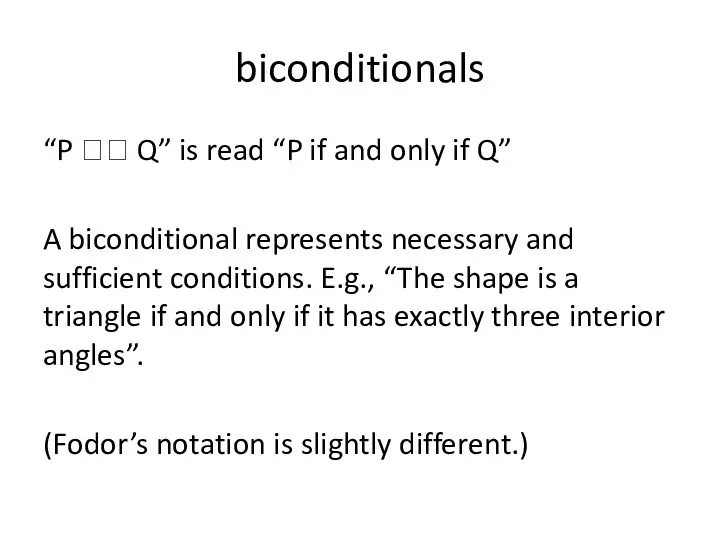
biconditionals
“P ?? Q” is read “P if and only if Q”
A
biconditional represents necessary and sufficient conditions. E.g., “The shape is a triangle if and only if it has exactly three interior angles”.
(Fodor’s notation is slightly different.)
Слайд 20

Fodor says a reduction occurs when
S1x ? S2x
and...
S1x ?? P1x
S2x ?? P2x
P1x ? P2x
where the S terms come from a special science and the P terms come from a physical science
Слайд 21
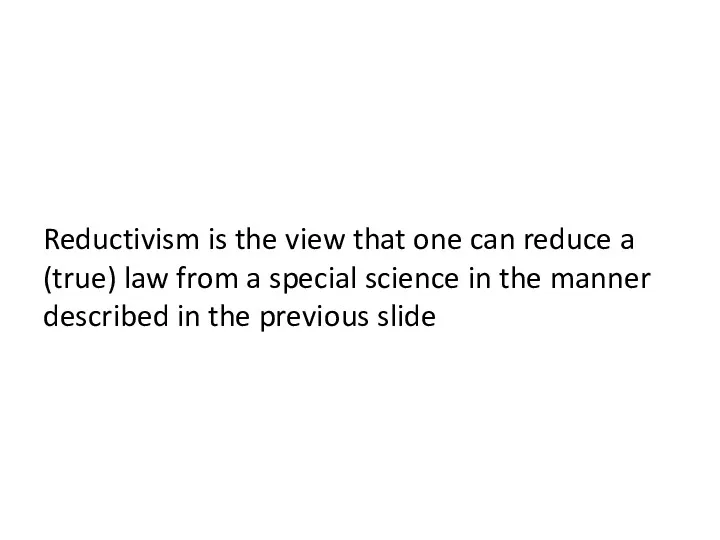
Reductivism is the view that one can reduce a (true) law
from a special science in the manner described in the previous slide
Слайд 22
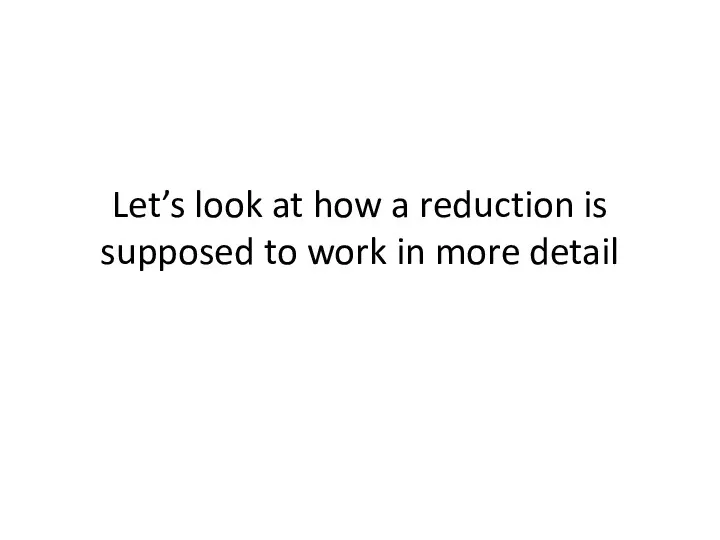
Let’s look at how a reduction is supposed to work in
more detail
Слайд 23

Thomas Gresham (1519-1579)
Слайд 24
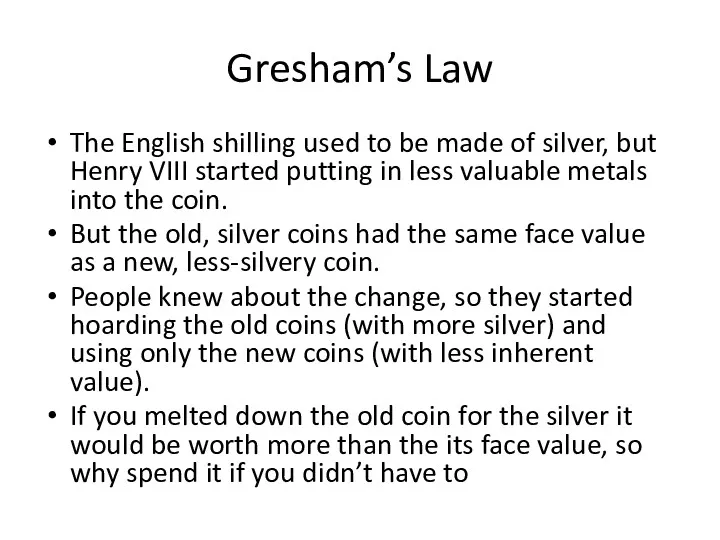
Gresham’s Law
The English shilling used to be made of silver, but
Henry VIII started putting in less valuable metals into the coin.
But the old, silver coins had the same face value as a new, less-silvery coin.
People knew about the change, so they started hoarding the old coins (with more silver) and using only the new coins (with less inherent value).
If you melted down the old coin for the silver it would be worth more than the its face value, so why spend it if you didn’t have to
Слайд 25
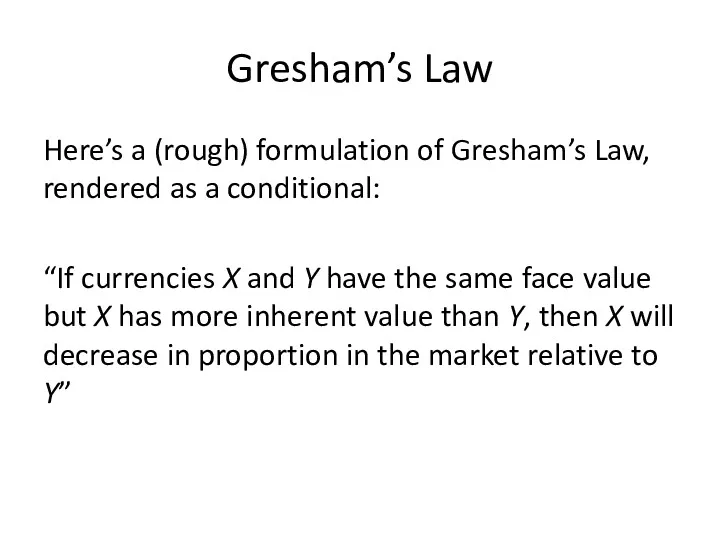
Gresham’s Law
Here’s a (rough) formulation of Gresham’s Law, rendered as a
conditional:
“If currencies X and Y have the same face value but X has more inherent value than Y, then X will decrease in proportion in the market relative to Y”
Слайд 26
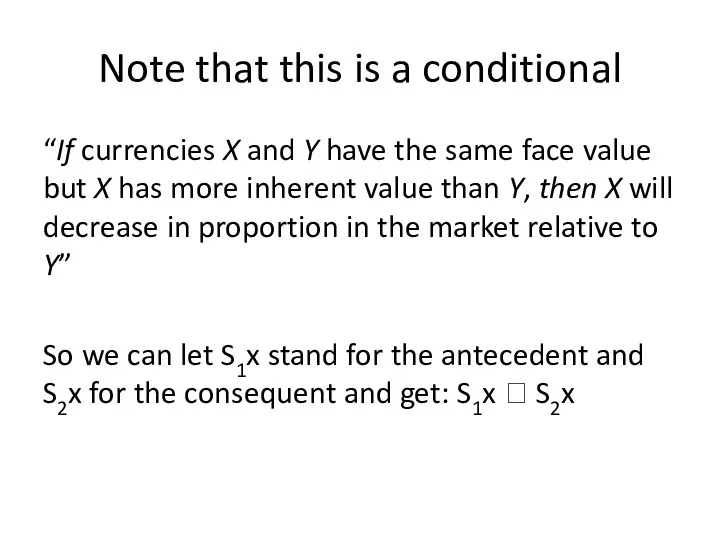
Note that this is a conditional
“If currencies X and Y have
the same face value but X has more inherent value than Y, then X will decrease in proportion in the market relative to Y”
So we can let S1x stand for the antecedent and S2x for the consequent and get: S1x ? S2x
Слайд 27
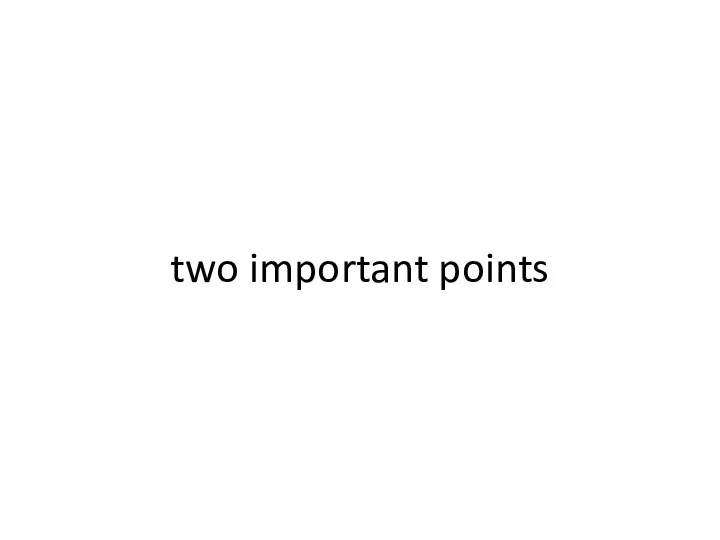
Слайд 28
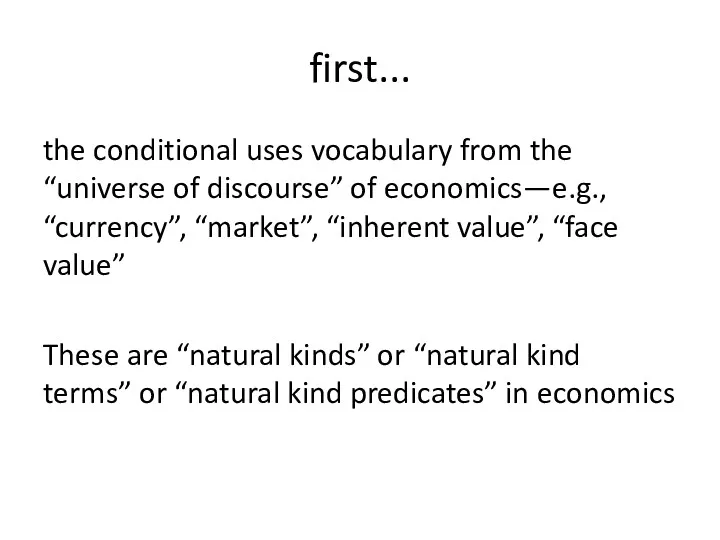
first...
the conditional uses vocabulary from the “universe of discourse” of economics—e.g.,
“currency”, “market”, “inherent value”, “face value”
These are “natural kinds” or “natural kind terms” or “natural kind predicates” in economics
Слайд 29
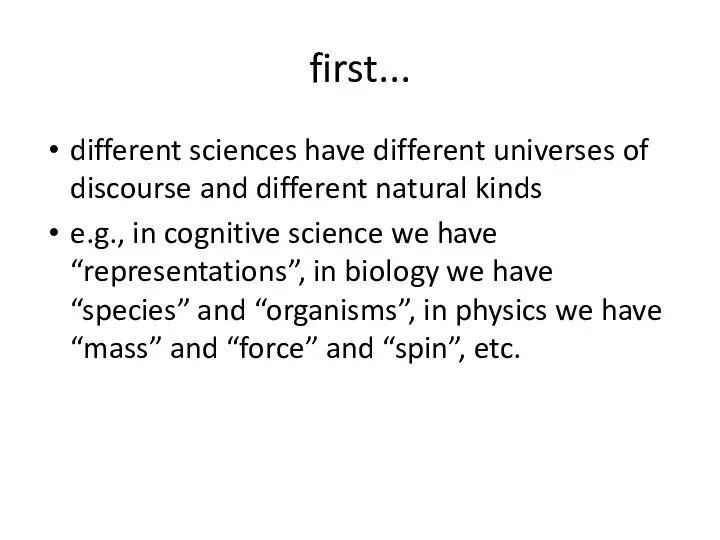
first...
different sciences have different universes of discourse and different natural kinds
e.g.,
in cognitive science we have “representations”, in biology we have “species” and “organisms”, in physics we have “mass” and “force” and “spin”, etc.
Слайд 30
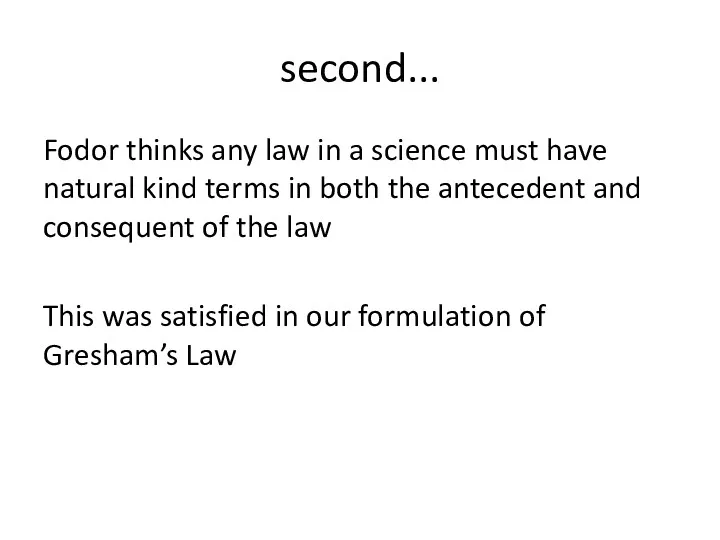
second...
Fodor thinks any law in a science must have natural kind
terms in both the antecedent and consequent of the law
This was satisfied in our formulation of Gresham’s Law
Слайд 31
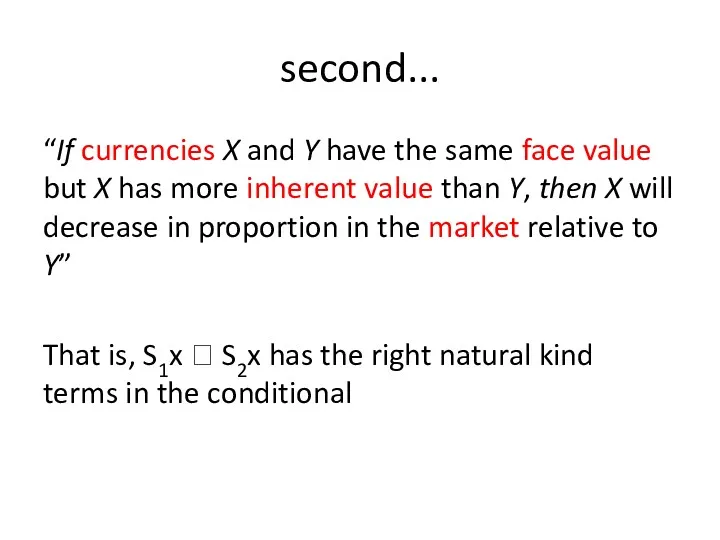
second...
“If currencies X and Y have the same face value but
X has more inherent value than Y, then X will decrease in proportion in the market relative to Y”
That is, S1x ? S2x has the right natural kind terms in the conditional
Слайд 32
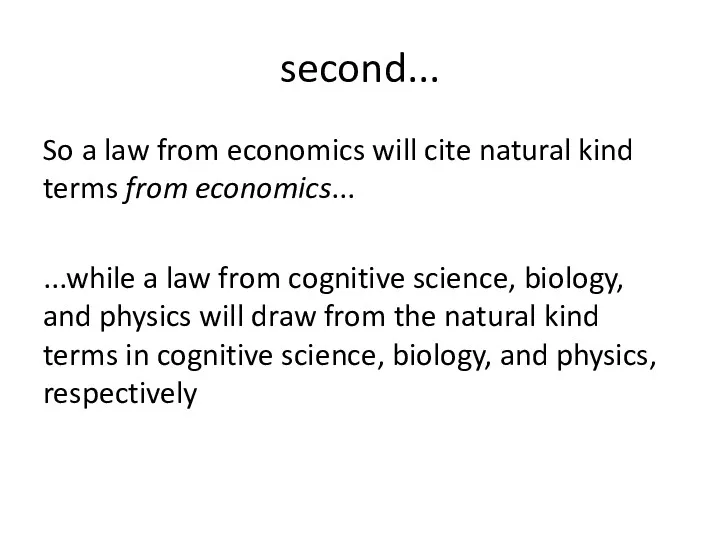
second...
So a law from economics will cite natural kind terms from
economics...
...while a law from cognitive science, biology, and physics will draw from the natural kind terms in cognitive science, biology, and physics, respectively
Слайд 33
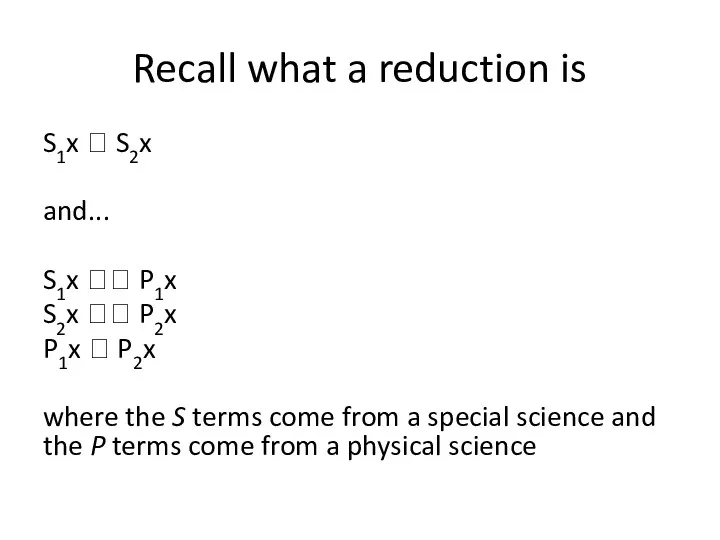
Recall what a reduction is
S1x ? S2x
and...
S1x ?? P1x
S2x
?? P2x
P1x ? P2x
where the S terms come from a special science and the P terms come from a physical science
Слайд 34
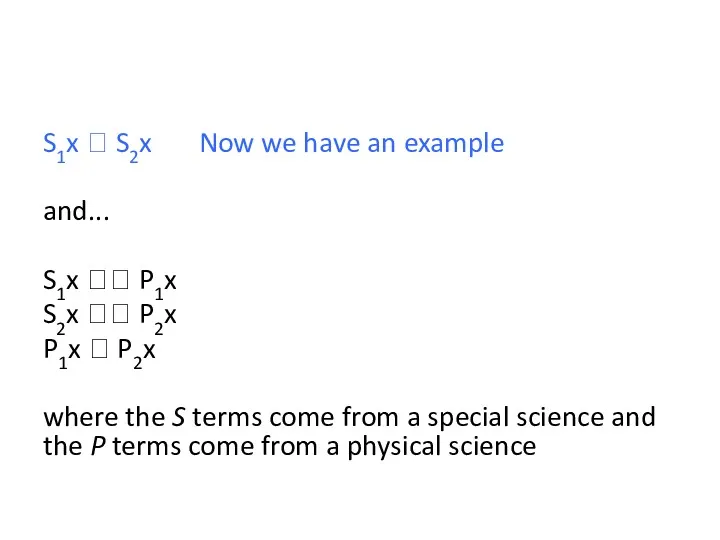
S1x ? S2x Now we have an example
and...
S1x ?? P1x
S2x
?? P2x
P1x ? P2x
where the S terms come from a special science and the P terms come from a physical science
Слайд 35
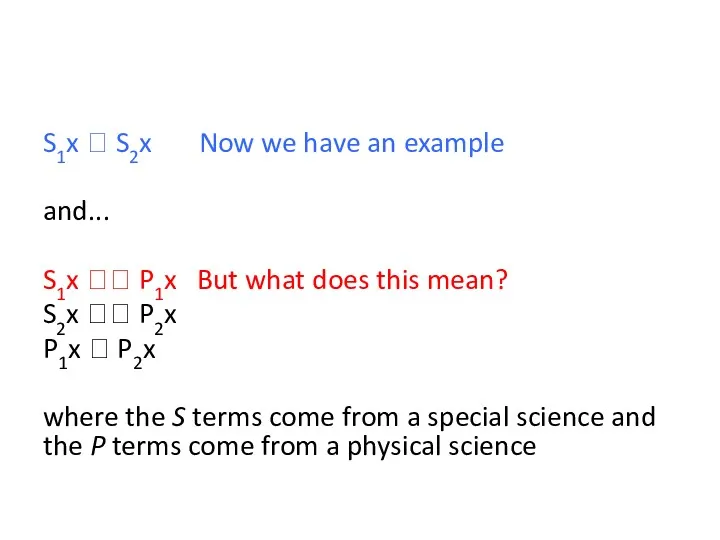
S1x ? S2x Now we have an example
and...
S1x ?? P1x But
what does this mean?
S2x ?? P2x
P1x ? P2x
where the S terms come from a special science and the P terms come from a physical science
Слайд 36
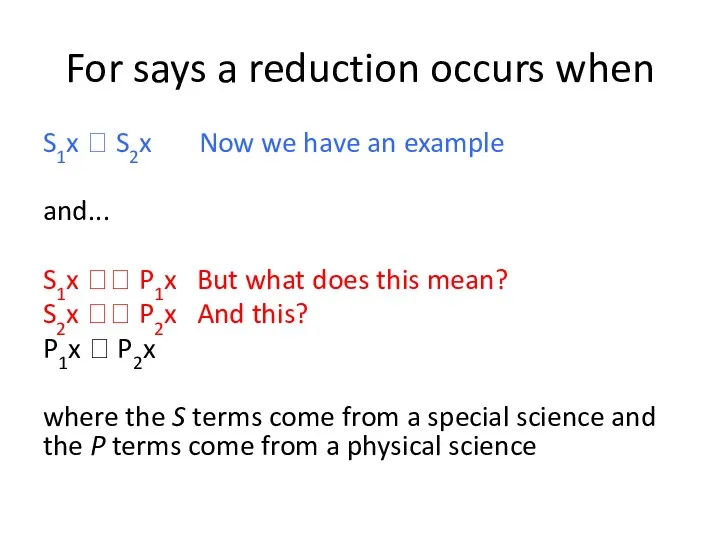
For says a reduction occurs when
S1x ? S2x Now we have
an example
and...
S1x ?? P1x But what does this mean?
S2x ?? P2x And this?
P1x ? P2x
where the S terms come from a special science and the P terms come from a physical science
Слайд 37
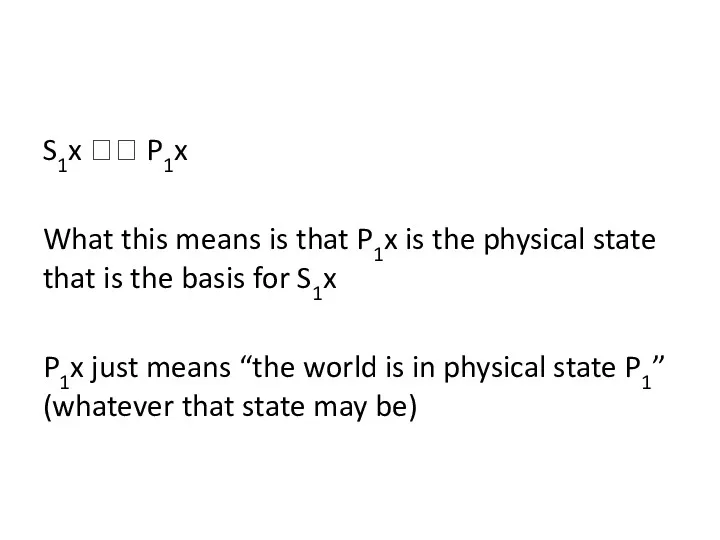
S1x ?? P1x
What this means is that P1x is the
physical state that is the basis for S1x
P1x just means “the world is in physical state P1” (whatever that state may be)
Слайд 38
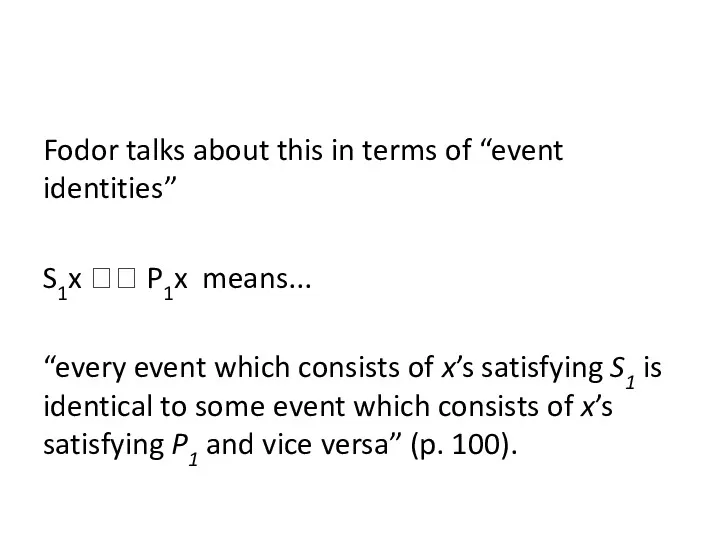
Fodor talks about this in terms of “event identities”
S1x ?? P1x
means...
“every event which consists of x’s satisfying S1 is identical to some event which consists of x’s satisfying P1 and vice versa” (p. 100).
Слайд 39
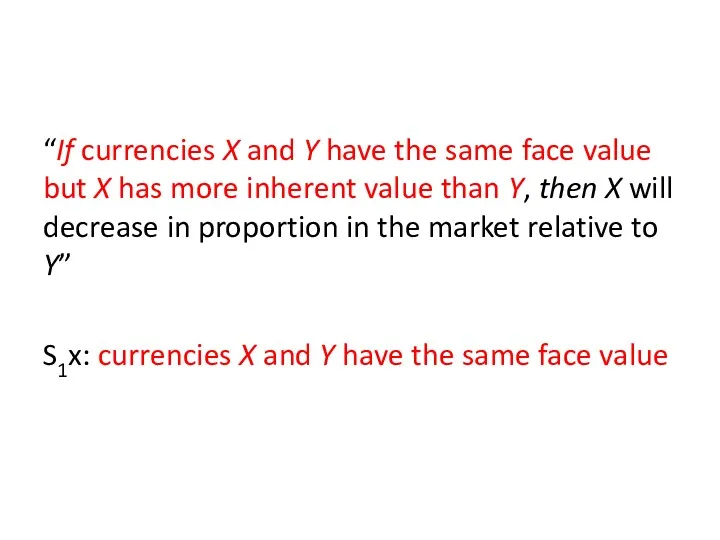
“If currencies X and Y have the same face value but
X has more inherent value than Y, then X will decrease in proportion in the market relative to Y”
S1x: currencies X and Y have the same face value
Слайд 40
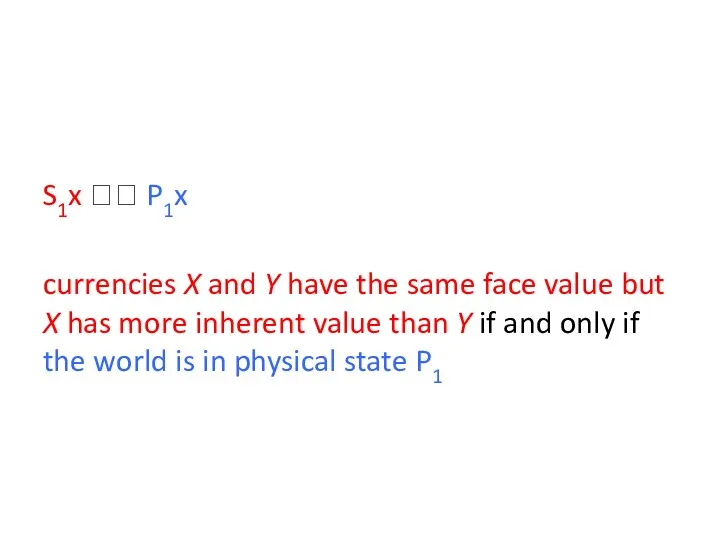
S1x ?? P1x
currencies X and Y have the same face value
but X has more inherent value than Y if and only if the world is in physical state P1
Слайд 41
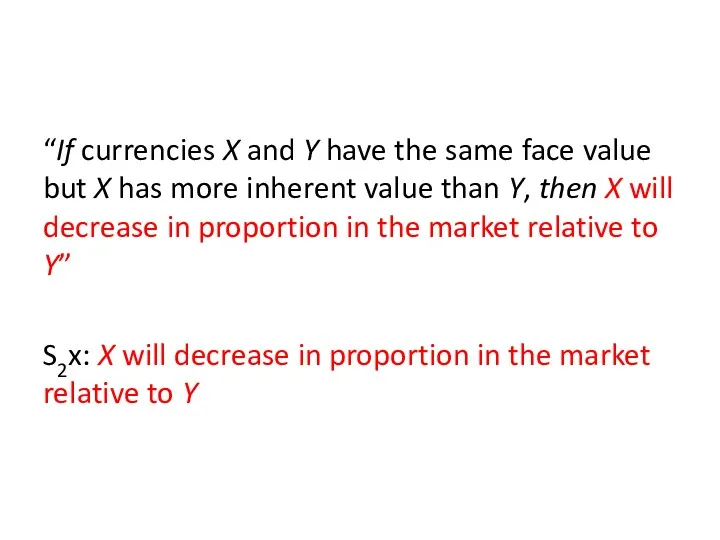
“If currencies X and Y have the same face value but
X has more inherent value than Y, then X will decrease in proportion in the market relative to Y”
S2x: X will decrease in proportion in the market relative to Y
Слайд 42
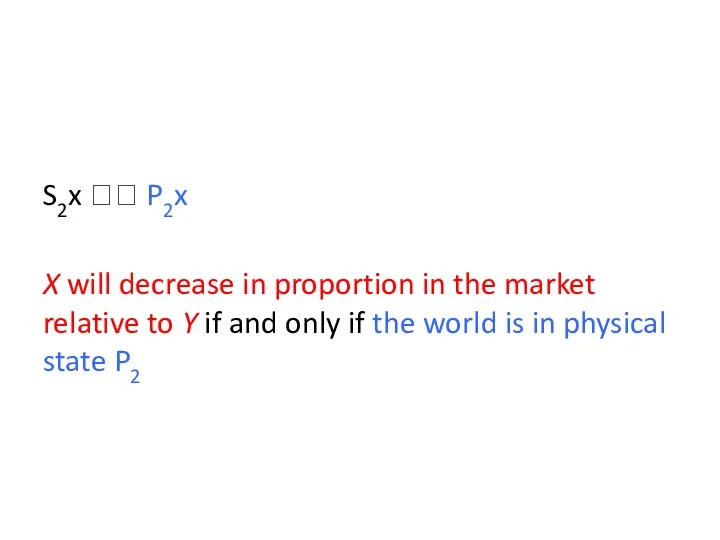
S2x ?? P2x
X will decrease in proportion in the market relative
to Y if and only if the world is in physical state P2
Слайд 43
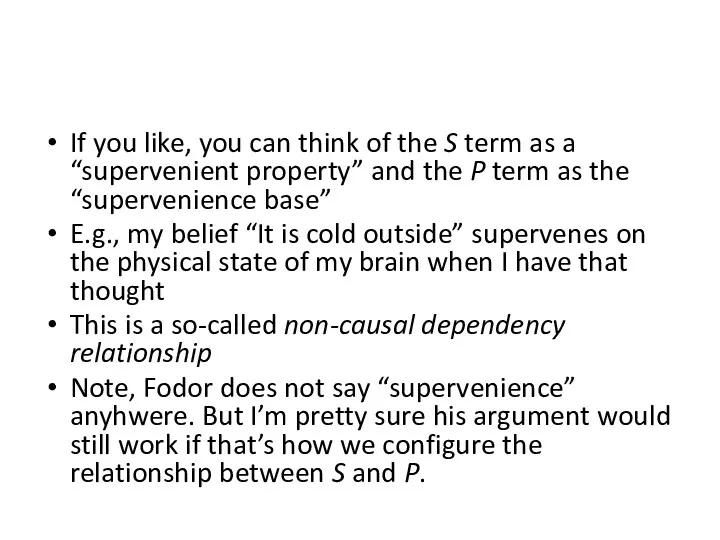
If you like, you can think of the S term as
a “supervenient property” and the P term as the “supervenience base”
E.g., my belief “It is cold outside” supervenes on the physical state of my brain when I have that thought
This is a so-called non-causal dependency relationship
Note, Fodor does not say “supervenience” anyhwere. But I’m pretty sure his argument would still work if that’s how we configure the relationship between S and P.
Слайд 44
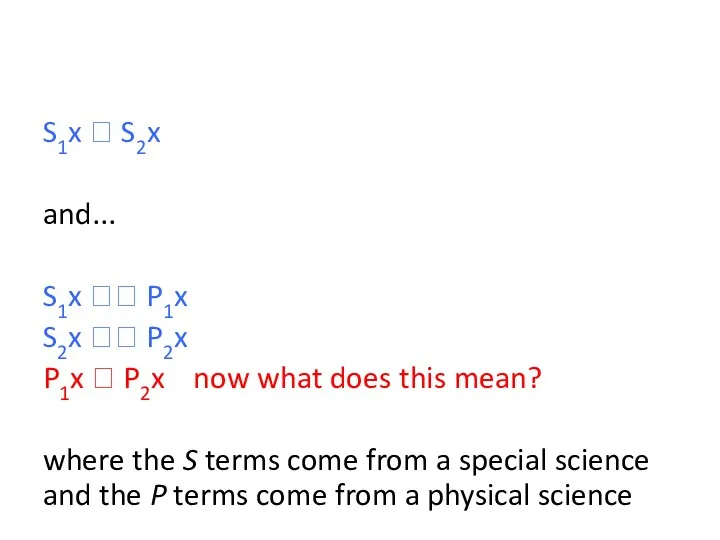
S1x ? S2x
and...
S1x ?? P1x
S2x ?? P2x
P1x ? P2x
now what does this mean?
where the S terms come from a special science and the P terms come from a physical science
Слайд 45
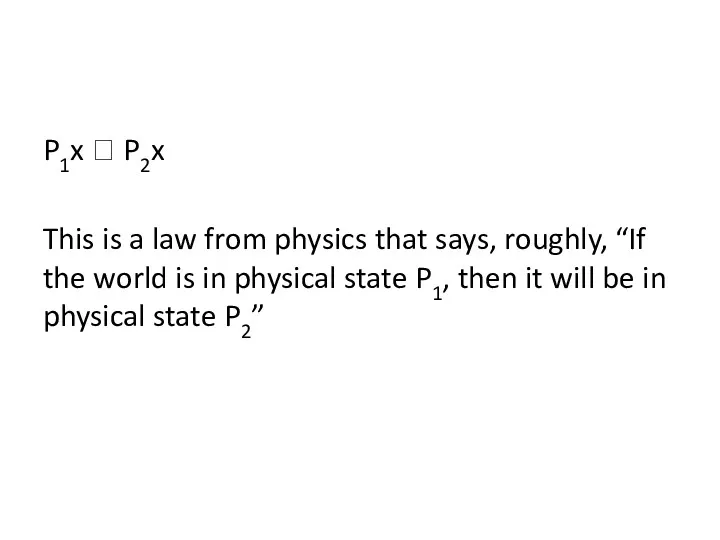
P1x ? P2x
This is a law from physics that says,
roughly, “If the world is in physical state P1, then it will be in physical state P2”
Слайд 46
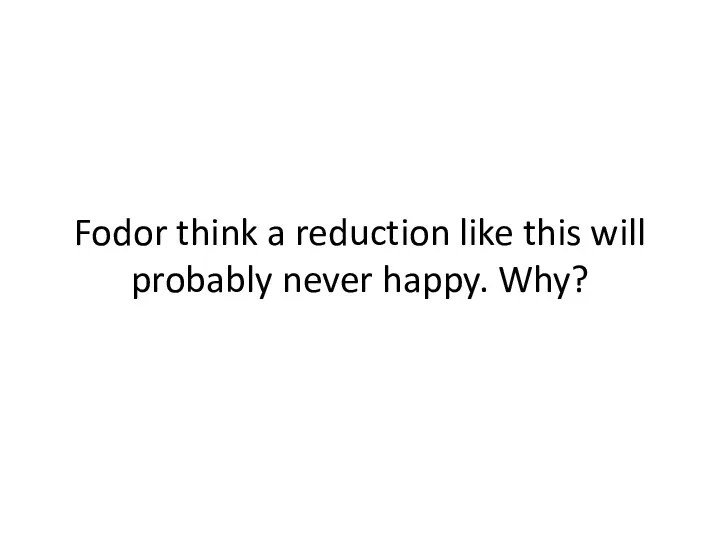
Fodor think a reduction like this will probably never happy. Why?
Слайд 47
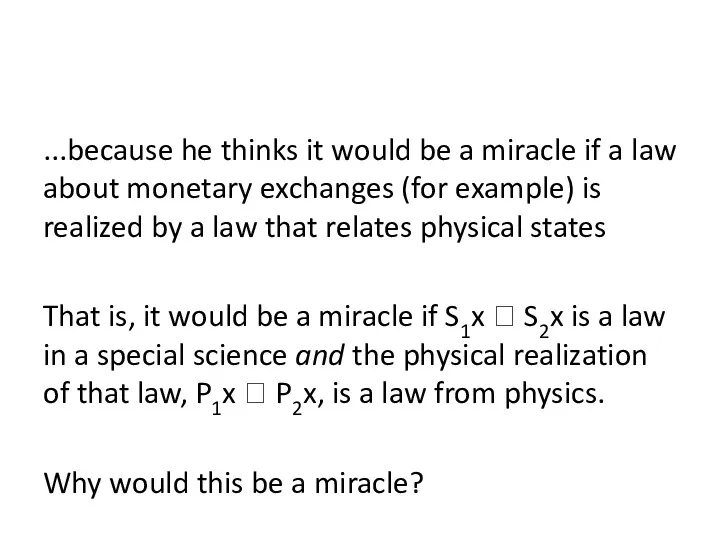
...because he thinks it would be a miracle if a law
about monetary exchanges (for example) is realized by a law that relates physical states
That is, it would be a miracle if S1x ? S2x is a law in a special science and the physical realization of that law, P1x ? P2x, is a law from physics.
Why would this be a miracle?
Слайд 48
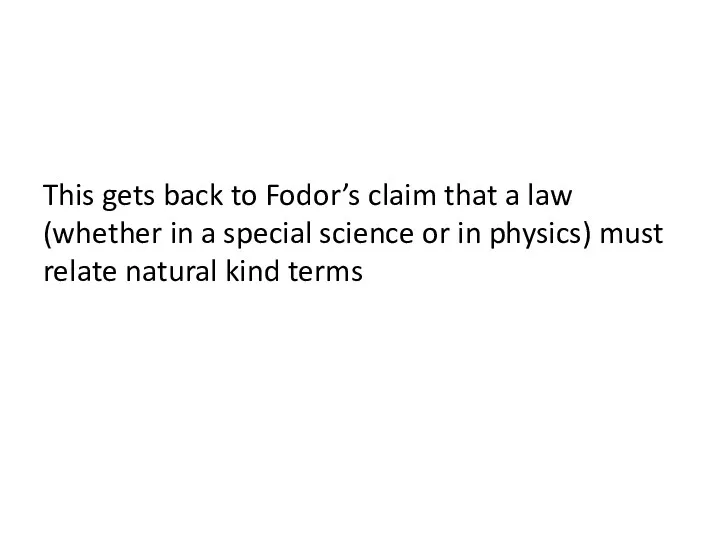
This gets back to Fodor’s claim that a law (whether in
a special science or in physics) must relate natural kind terms
Слайд 49
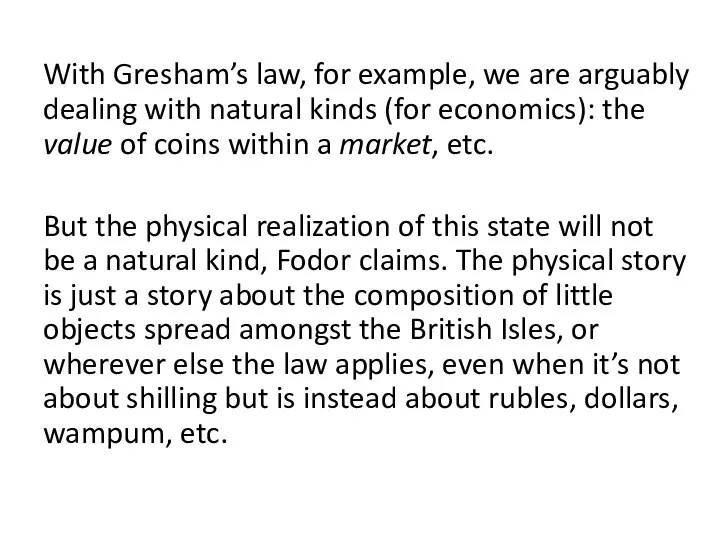
With Gresham’s law, for example, we are arguably dealing with natural
kinds (for economics): the value of coins within a market, etc.
But the physical realization of this state will not be a natural kind, Fodor claims. The physical story is just a story about the composition of little objects spread amongst the British Isles, or wherever else the law applies, even when it’s not about shilling but is instead about rubles, dollars, wampum, etc.
Слайд 50
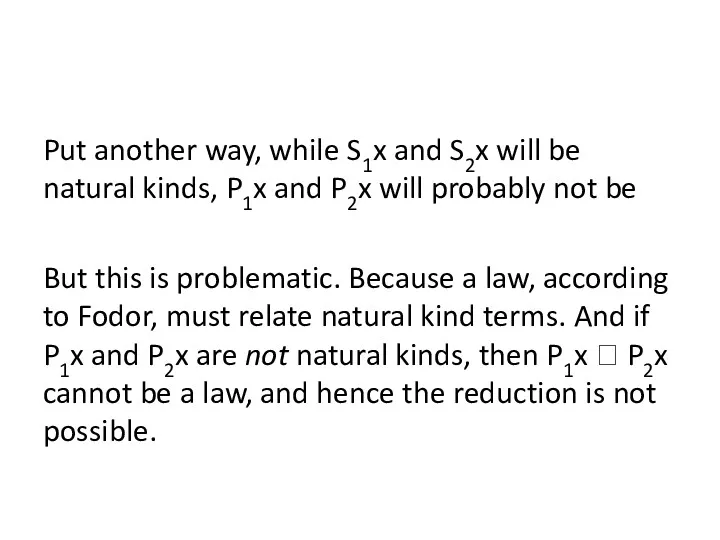
Put another way, while S1x and S2x will be natural kinds,
P1x and P2x will probably not be
But this is problematic. Because a law, according to Fodor, must relate natural kind terms. And if P1x and P2x are not natural kinds, then P1x ? P2x cannot be a law, and hence the reduction is not possible.
Слайд 51
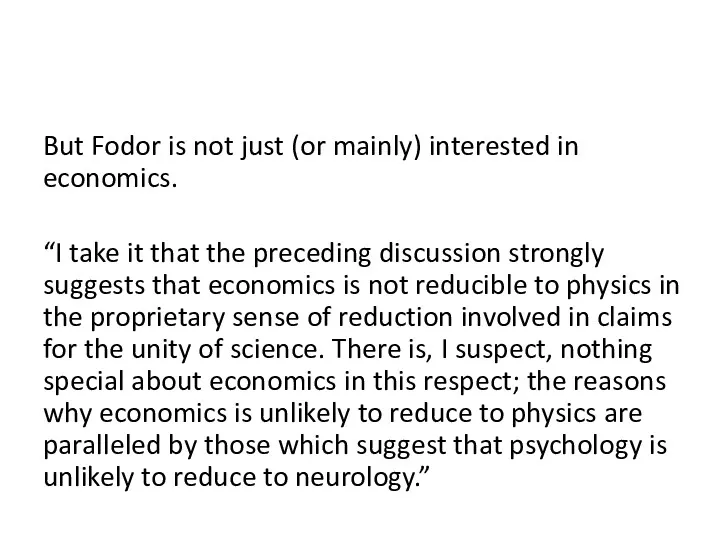
But Fodor is not just (or mainly) interested in economics.
“I take
it that the preceding discussion strongly suggests that economics is not reducible to physics in the proprietary sense of reduction involved in claims for the unity of science. There is, I suspect, nothing special about economics in this respect; the reasons why economics is unlikely to reduce to physics are paralleled by those which suggest that psychology is unlikely to reduce to neurology.”
Слайд 52
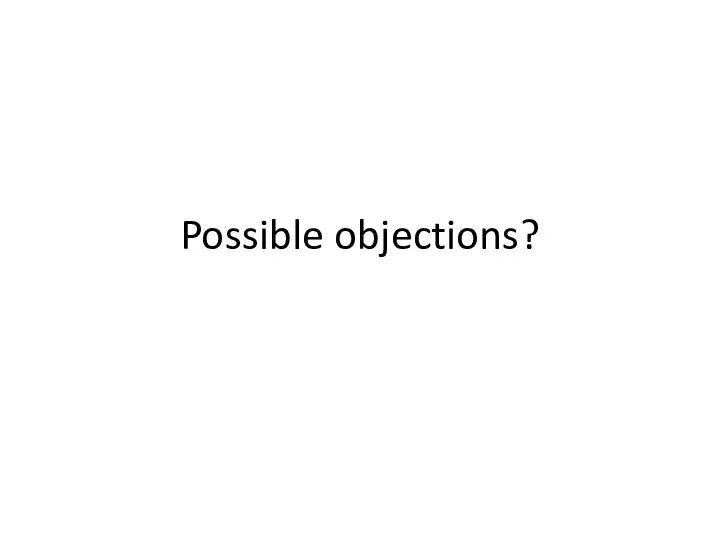
Слайд 53
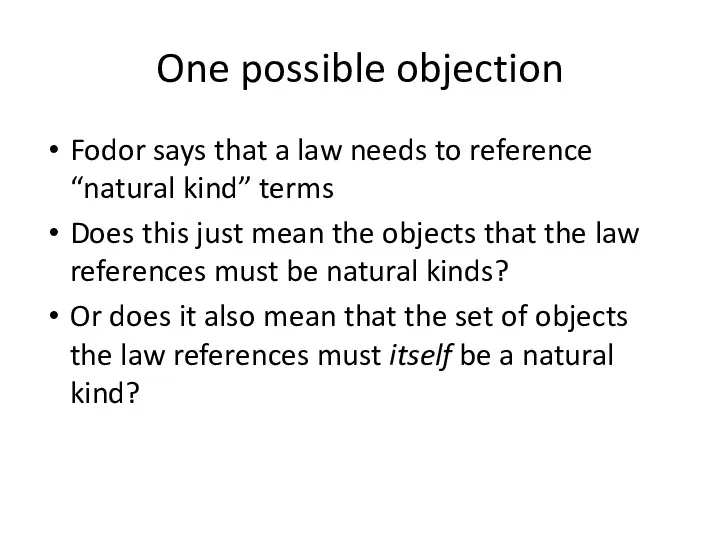
One possible objection
Fodor says that a law needs to reference “natural
kind” terms
Does this just mean the objects that the law references must be natural kinds?
Or does it also mean that the set of objects the law references must itself be a natural kind?
Слайд 54
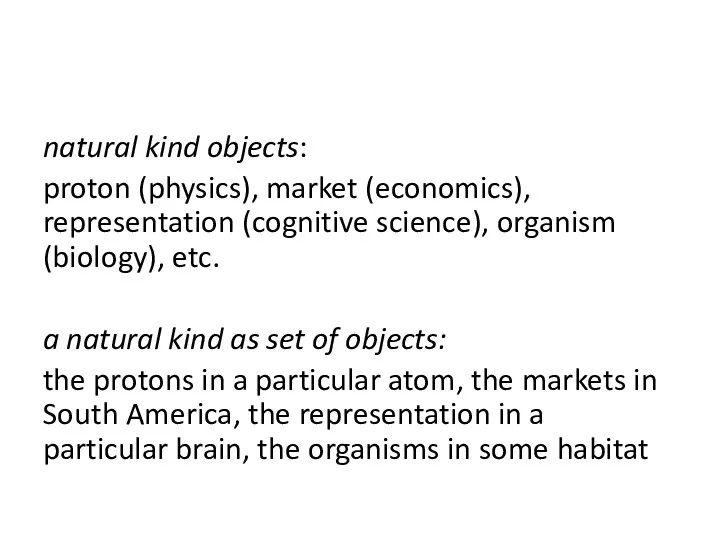
natural kind objects:
proton (physics), market (economics), representation (cognitive science), organism (biology),
etc.
a natural kind as set of objects:
the protons in a particular atom, the markets in South America, the representation in a particular brain, the organisms in some habitat
Слайд 55
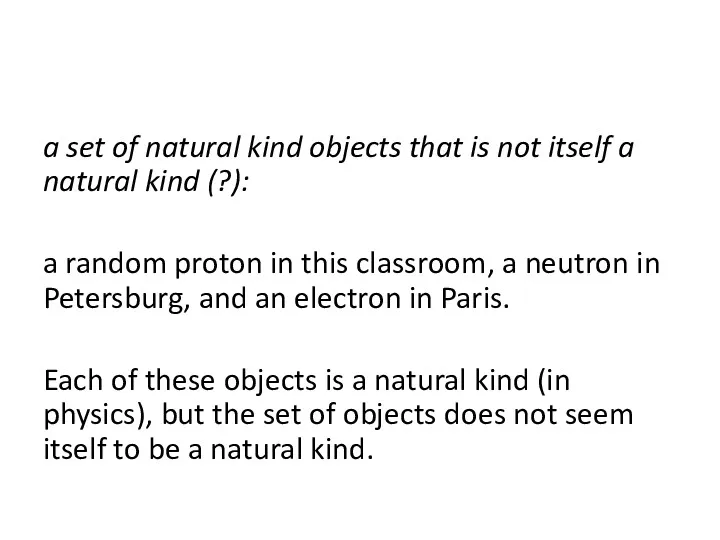
a set of natural kind objects that is not itself a
natural kind (?):
a random proton in this classroom, a neutron in Petersburg, and an electron in Paris.
Each of these objects is a natural kind (in physics), but the set of objects does not seem itself to be a natural kind.
Слайд 56
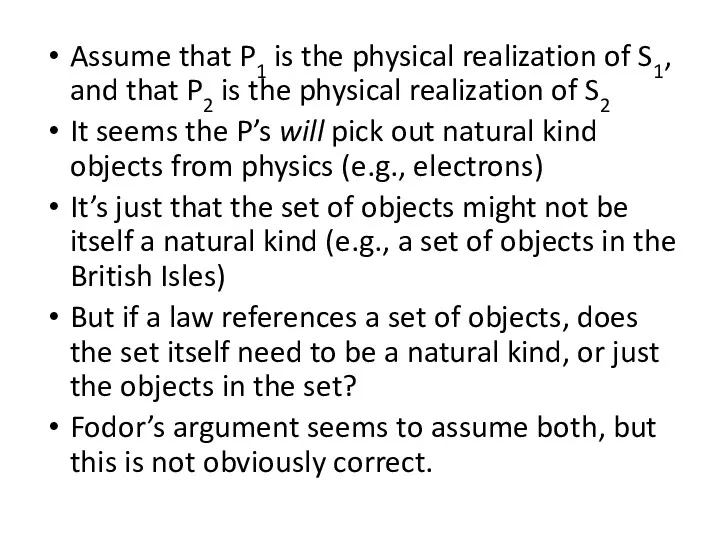
Assume that P1 is the physical realization of S1, and that
P2 is the physical realization of S2
It seems the P’s will pick out natural kind objects from physics (e.g., electrons)
It’s just that the set of objects might not be itself a natural kind (e.g., a set of objects in the British Isles)
But if a law references a set of objects, does the set itself need to be a natural kind, or just the objects in the set?
Fodor’s argument seems to assume both, but this is not obviously correct.
Слайд 57
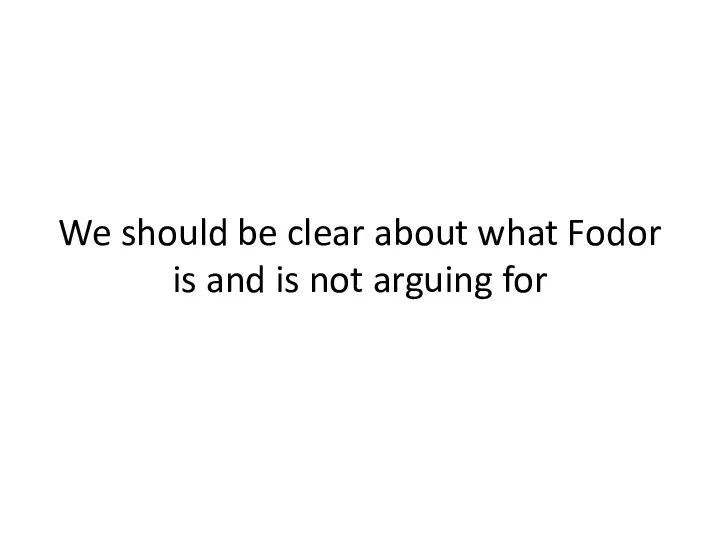
We should be clear about what Fodor is and is not
arguing for
Слайд 58
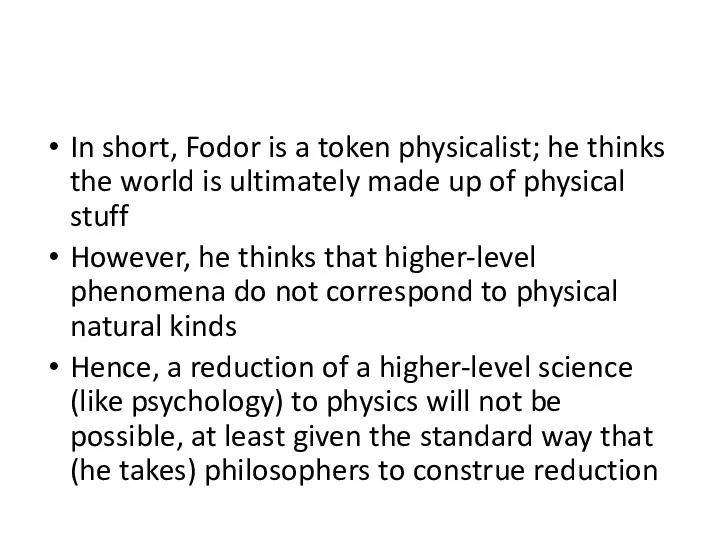
In short, Fodor is a token physicalist; he thinks the world
is ultimately made up of physical stuff
However, he thinks that higher-level phenomena do not correspond to physical natural kinds
Hence, a reduction of a higher-level science (like psychology) to physics will not be possible, at least given the standard way that (he takes) philosophers to construe reduction
Слайд 59
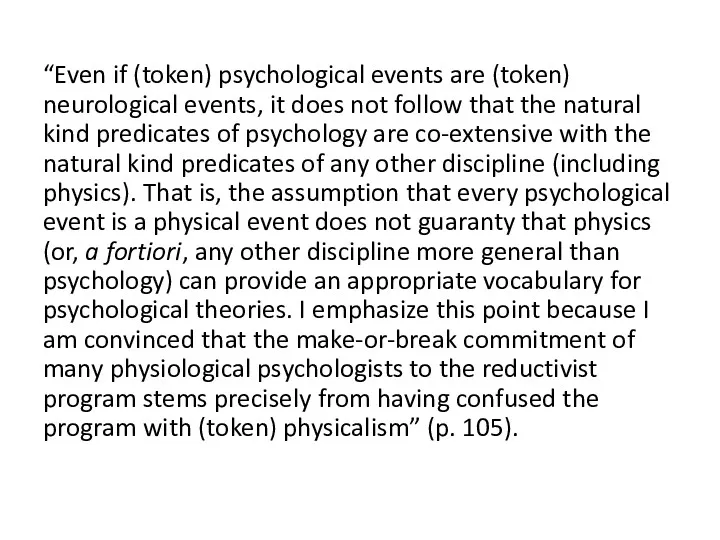
“Even if (token) psychological events are (token) neurological events, it does
not follow that the natural kind predicates of psychology are co-extensive with the natural kind predicates of any other discipline (including physics). That is, the assumption that every psychological event is a physical event does not guaranty that physics (or, a fortiori, any other discipline more general than psychology) can provide an appropriate vocabulary for psychological theories. I emphasize this point because I am convinced that the make-or-break commitment of many physiological psychologists to the reductivist program stems precisely from having confused the program with (token) physicalism” (p. 105).
Слайд 60

a different (and more popular?) take
Слайд 61
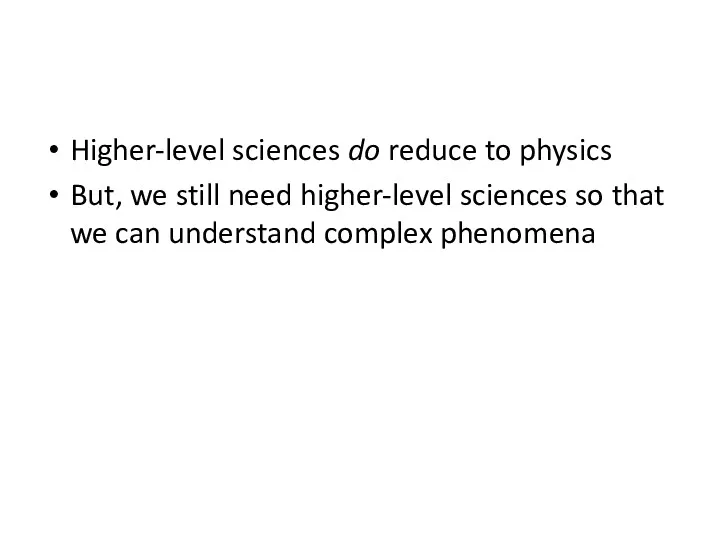
Higher-level sciences do reduce to physics
But, we still need higher-level sciences
so that we can understand complex phenomena
Слайд 62
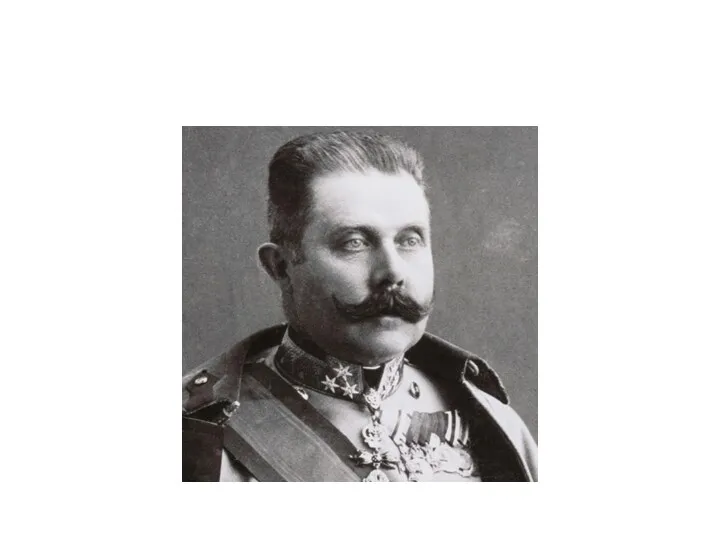
Слайд 63
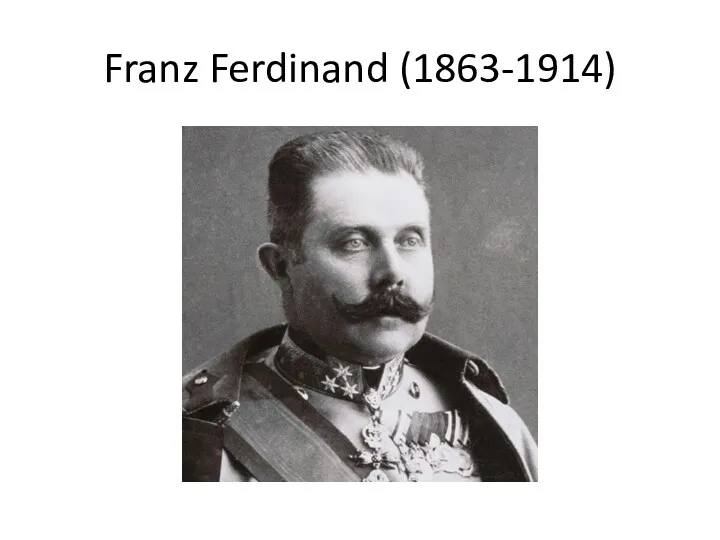
Franz Ferdinand (1863-1914)
Слайд 64
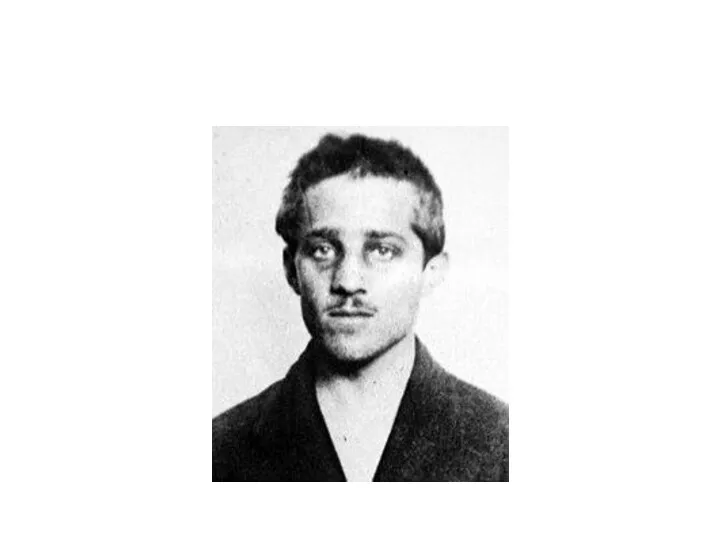
Слайд 65
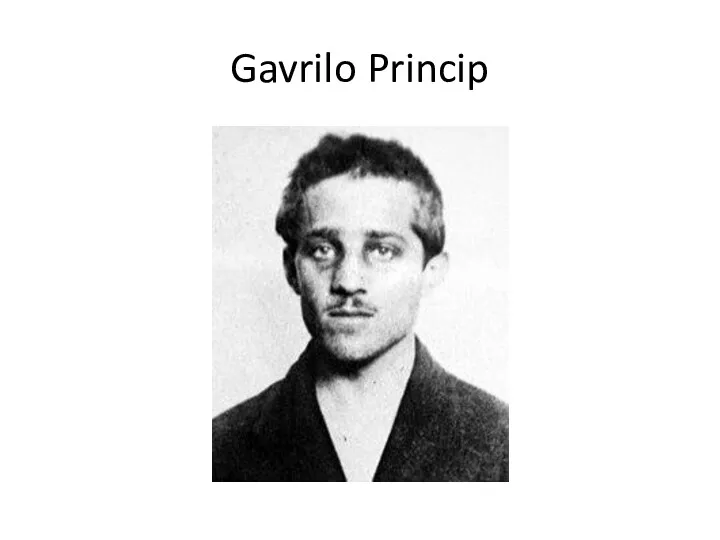
Слайд 66
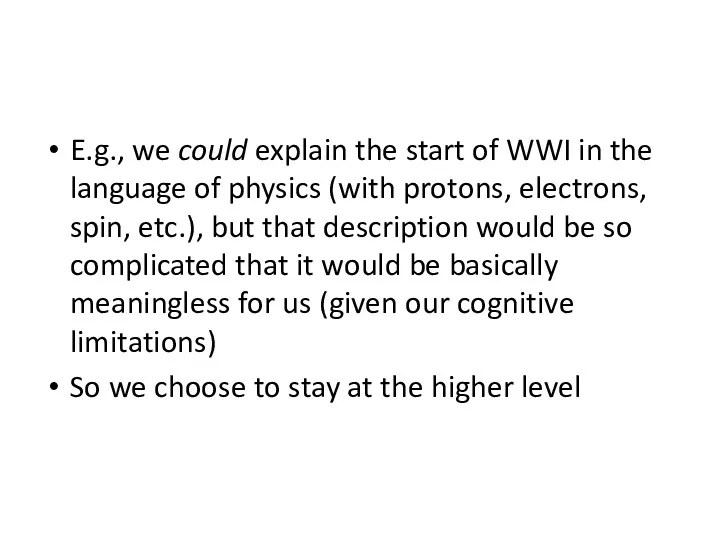
E.g., we could explain the start of WWI in the language
of physics (with protons, electrons, spin, etc.), but that description would be so complicated that it would be basically meaningless for us (given our cognitive limitations)
So we choose to stay at the higher level
Слайд 67
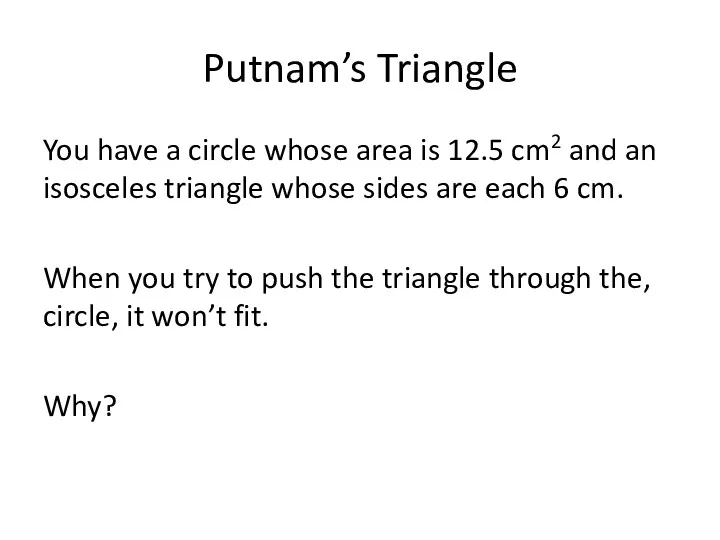
Putnam’s Triangle
You have a circle whose area is 12.5 cm2 and
an isosceles triangle whose sides are each 6 cm.
When you try to push the triangle through the, circle, it won’t fit.
Why?
Слайд 68
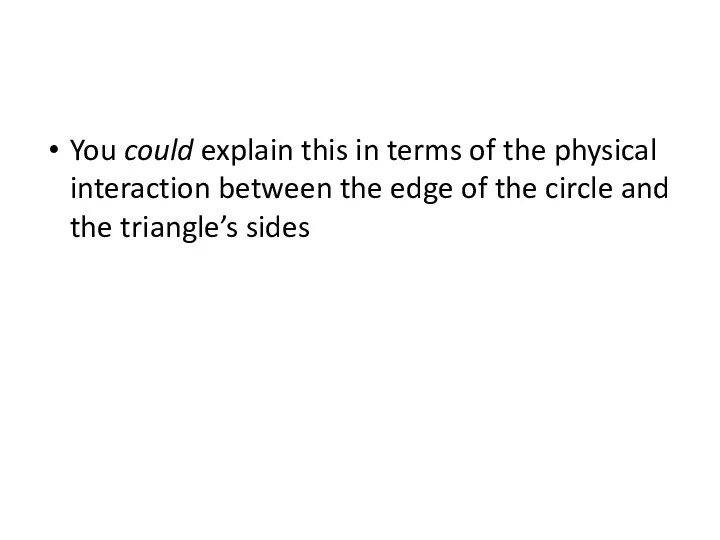
You could explain this in terms of the physical interaction between
the edge of the circle and the triangle’s sides
Слайд 69
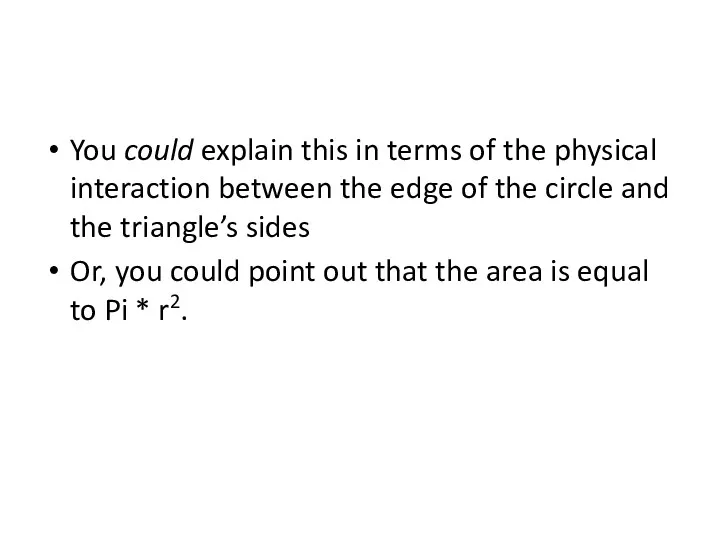
You could explain this in terms of the physical interaction between
the edge of the circle and the triangle’s sides
Or, you could point out that the area is equal to Pi * r2.
Слайд 70
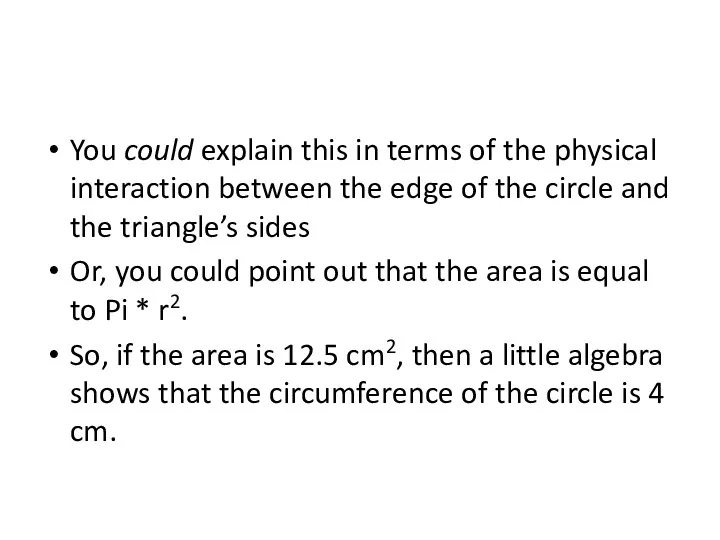
You could explain this in terms of the physical interaction between
the edge of the circle and the triangle’s sides
Or, you could point out that the area is equal to Pi * r2.
So, if the area is 12.5 cm2, then a little algebra shows that the circumference of the circle is 4 cm.
Слайд 71
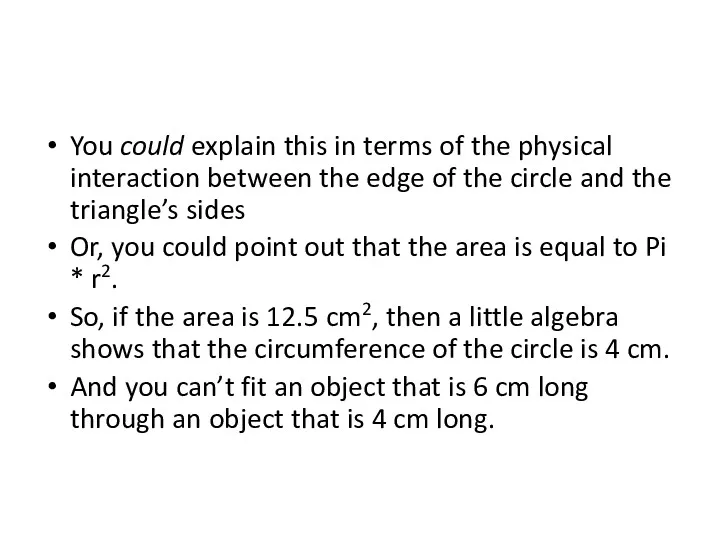
You could explain this in terms of the physical interaction between
the edge of the circle and the triangle’s sides
Or, you could point out that the area is equal to Pi * r2.
So, if the area is 12.5 cm2, then a little algebra shows that the circumference of the circle is 4 cm.
And you can’t fit an object that is 6 cm long through an object that is 4 cm long.
Слайд 72
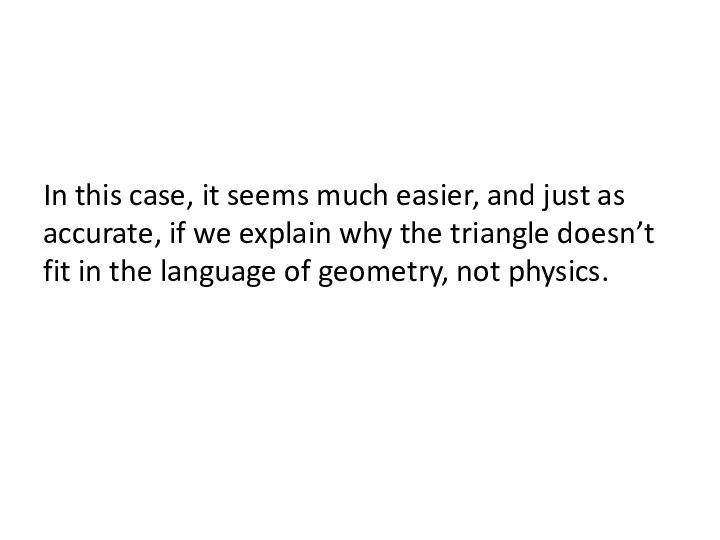
In this case, it seems much easier, and just as accurate,
if we explain why the triangle doesn’t fit in the language of geometry, not physics.
Слайд 73
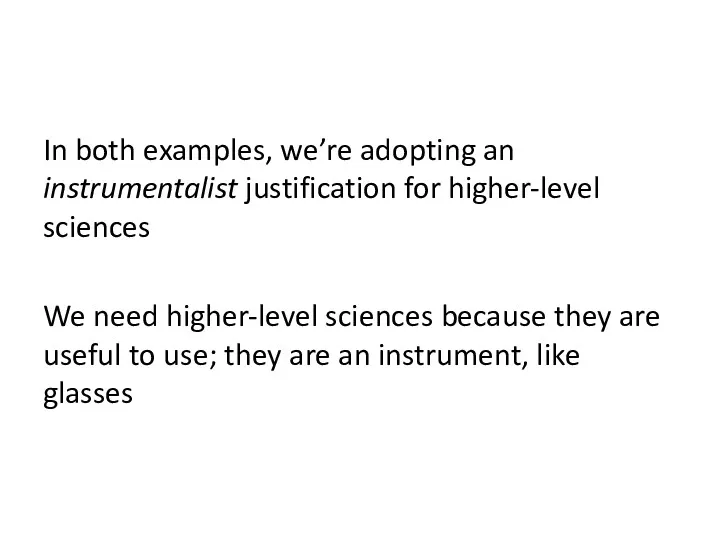
In both examples, we’re adopting an instrumentalist justification for higher-level sciences
We
need higher-level sciences because they are useful to use; they are an instrument, like glasses








































































 ММ-задание по R-диагностике заболеваний органов дыхания
ММ-задание по R-диагностике заболеваний органов дыхания Магнитное поле.Вектор магнитной индукции
Магнитное поле.Вектор магнитной индукции Единый деловой стиль одежды в школе
Единый деловой стиль одежды в школе Детские вопросы и как на них отвечать
Детские вопросы и как на них отвечать Найди недостающий фрагмент. Развивающая игра для детей
Найди недостающий фрагмент. Развивающая игра для детей Инновационный менеджмент. Лекция 2
Инновационный менеджмент. Лекция 2 Приглашение на свадьбу
Приглашение на свадьбу Электрические колебания. Переменный ток
Электрические колебания. Переменный ток родительское собрание
родительское собрание Bekanntschaft. Thema 1
Bekanntschaft. Thema 1 Кодирование информации, 8 класс
Кодирование информации, 8 класс книга, презентация
книга, презентация Лексикология и ее разделы
Лексикология и ее разделы Особенности проекта НВАЭС-2
Особенности проекта НВАЭС-2 Профилактика наследственных заболеваний. (Лекция 6)
Профилактика наследственных заболеваний. (Лекция 6) Поговорил бы кто со мной...Телефон доверия.
Поговорил бы кто со мной...Телефон доверия. Моя профессия педагог-психолог
Моя профессия педагог-психолог Ресурсы предприятия
Ресурсы предприятия Презентация. Летний оздоровительный лагерь.
Презентация. Летний оздоровительный лагерь. Автоматизация звука [Л]
Автоматизация звука [Л] Вопросы знатокам 10-11 классов
Вопросы знатокам 10-11 классов Дорожные знаки. Что расскажет улица
Дорожные знаки. Что расскажет улица Культура Ярославского края в 19 веке. 4 класс
Культура Ярославского края в 19 веке. 4 класс Толкование норм права
Толкование норм права Метод качественной оценки риска
Метод качественной оценки риска Эволюция менеджмента
Эволюция менеджмента Город сквозь времена и страны
Город сквозь времена и страны iGRUShKI_IZ_POROLONA_aGAFONOVA_r_R
iGRUShKI_IZ_POROLONA_aGAFONOVA_r_R